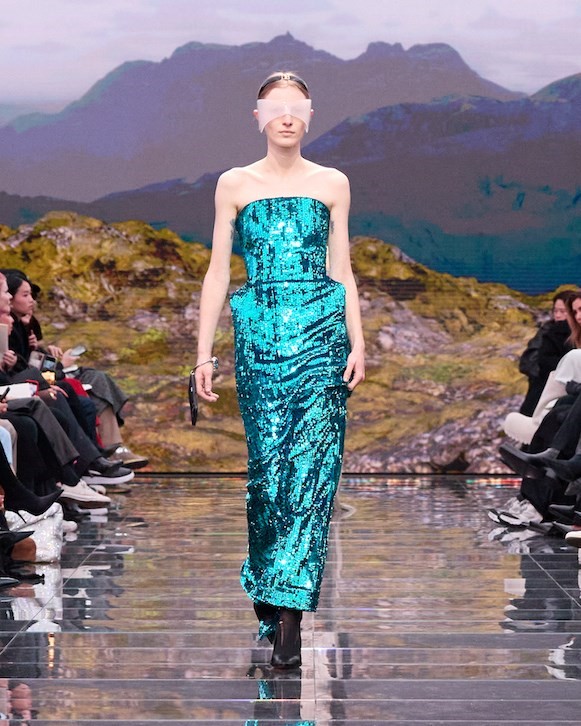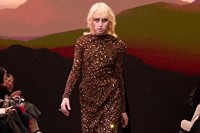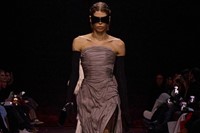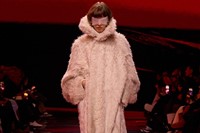Before his Autumn/Winter 2024 Balenciaga show Sunday morning, Demna released a one-minute 32-second voice note to replace the traditional post-collection dissection designers undertake to an ever-increasing throng of journalists. As opposed to answering questions about the clothes he had just shown, Demna decided to pose questions about the ones he was about to show. “What is luxury? What is fashion and why does it even matter? Who do I do what I do for? Is fashion enough? In a world oversaturated by content, is anything ever enough? What is enough?” Considering just how many hands clutching iPhones are generally thrust into designers’ faces post-show – and a new fad with journalists being to record a video of the process, as opposed to just the sound – the answer to the second-to-last question is: probably no.
But the other questions seem more interesting, deeper and more meaningful. At the end of four weeks of womenswear shows, coming very shortly after three weeks of menswear presentations and a brief couture sojourn, our collective fashion brains are somewhat frazzled. We know that not everything we have seen really matters, but does anything? Will anything really change the way we dress, or the form of clothing today?
It’s interesting that Demna is the one to pose this question, because he is a figure that has, arguably, changed fashion more than anyone else over the last decade. This season, incidentally, marks exactly ten years since he released his first collection for Vetements, shot as a lookbook rather than a show. Obviously, times have changed enormously, but fashion over the entire period between then and now has undeniably been shaped by what he’s done. In my mind, the oversized fit that is still omnipresent at many brands was sparked by Demna’s looks at Vetements – he wasn’t the originator, in that no big ideas like that can have a true origin point, but he was the one to dust it off, give it relevance, and inspire legions of copyists. And he’s working within the house of Cristobal Balenciaga, another figure whose fashion shaped the style of his era more than, arguably, any other talent. The 40s may have belonged to Dior, but the 50s and 60s were Balenciaga’s, his volumes, his eased fit, his architectonic silhouettes.
Today, however, Demna seems more interested in tackling the idea questions of luxury rather than fashion. Perhaps because luxury has become, in recent seasons more than ever, a watchword. “Luxury is, by definition, a kind of scarcity,” Demna reasoned – which, of course, is antithetical to the more-is-moreness of fashion right now. But what Demna reasoned was truly scarce wasn’t crocodile, nor un-buyable handbags with years-long waitlists, but creativity. Both past and present.
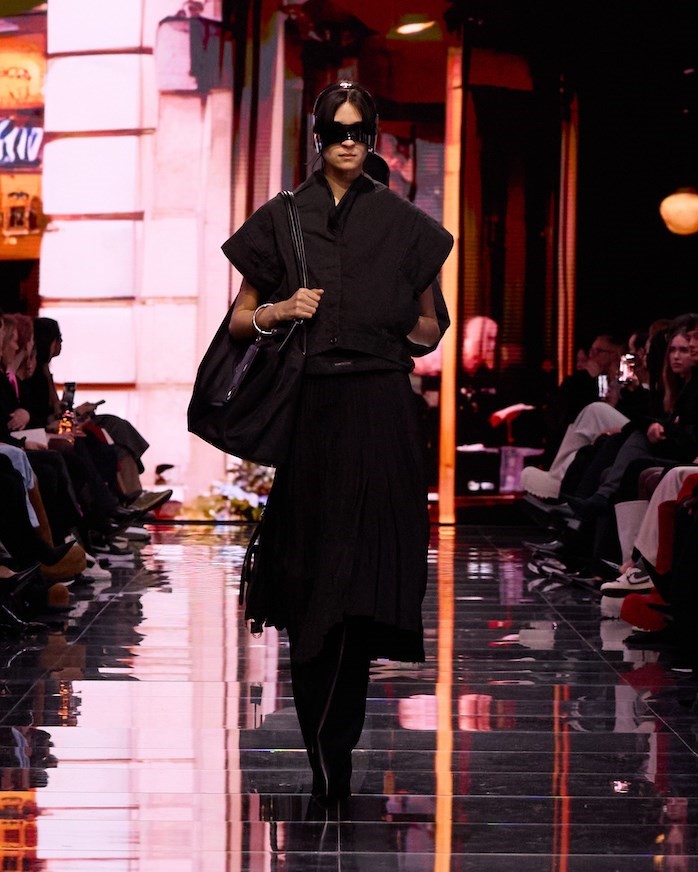

And, in reflection perhaps of the world’s unsatisfiable need for content, the backdrop to the show charted the progression of a day offline and then on, showing daylight dawning and dwindling in various locales, and then the churning of imagery and video that accompanies and distracts us from our everyday, before dissolving into static. What Demna seems to be trying to do is to make Balenciaga rise above all that white noise, and create something that will resonate. Which is rare, as he said.
There were ideas here that echoed the ones he’s been developing his own career – the fit and unfit of clothes, changing their rapport with the body, for instance, which is also something that Balenciaga himself was famously fascinated with. So there were lace stockings that were actually prints on stretch fabrics, cleaved close to the body, as well as his own version of Balenciaga’s unfitted suits, which seemed to have been deconstructed to just their linings to drape around the body, in the very denial of what tailoring should be. Other suits were ironic – the faux-fur coats twinned with matching dresses, down-stuffed jackets with coordinating bulky skirts. Balenciaga’s ‘Vareuse’, which Demna so gracefully referenced in his first haute couture show in 2021, with its shrugged off-the-shoulder shape, most memorably in a neon orange suit (that we put on our cover) was here pastiched with an inverted pair of trousers. The brilliant thing was how the effect was the same.
So for Demna this collection was a link between the past and future of Balenciaga, referencing silhouettes pulled from the archives, but melding them with his personal obsessions and stylistic tropes. So there were ball gowns and bubble dresses, but they were crafted from mashed-up sweatshirts and piled-up lingerie; evening dresses with emphasised hips harked back to the jutting basques of Balenciaga’s mid-century couture, but also to the construction of the ‘Hourglass’ jackets that Demna debuted for his first catwalk show in 2016. Clutched faux-furs seemed chic, but they had been trashed, their hems tattered, the pile chopped away. Hang-tags – executed in leather, but indistinguishable from cardboard to the naked eye – dangled from napes of neck and wrists. They were called ‘brooches’, the label itself becoming a decorative piece, something precious to flaunt, like jewellery. But they looked as if the items had been shoplifted – perhaps a musing on the notion of desire, which is, after all, what fashion is engineered to generate? Or, indeed, a commentary on the price tags fashion has always attached to creativity.
Those are the questions Demna is asking, and that make his Balenciaga collections important. He isn’t asking if you like this skirt, or want to buy this top. Although plenty of people do, of course. But it’s about something more fundamental, more meaningful. “The rethinking of the concept of beauty,” is one thing he says he’s interested in. He’s kind of achieved it, in a ten year span. That’s quite something.
